Hadassah
Inside Look
Our Groundbreaking Role
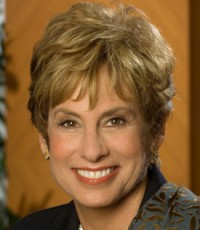 It amazes me how brilliant Hadassah leaders were to begin their Zionist work in 1914 with a public health and medical “needs assessment” of the population of prestate Israel. To do so, they raised the funds to send two Amerian nurses, Rachel Landy and Rose Kaplan, to do the job. Landy and Kaplan’s evaluations led to the establishment of Hadassah’s mother and child welfare clinics, the first of their kind in the land.
It amazes me how brilliant Hadassah leaders were to begin their Zionist work in 1914 with a public health and medical “needs assessment” of the population of prestate Israel. To do so, they raised the funds to send two Amerian nurses, Rachel Landy and Rose Kaplan, to do the job. Landy and Kaplan’s evaluations led to the establishment of Hadassah’s mother and child welfare clinics, the first of their kind in the land.
Today, 100 years later, members of Hadassah’s professional Nurses and Physicians Councils proudly retraced those two nurses’ footsteps when they participated in the most recent health care mission to Jerusalem (there have been more than 20!), From Concept to Cure: A Second Century of Healing.
As a nurse and cofounder of the Hadassah National Center for Nurses Councils, it gives me great personal pleasure to share with you a report written by three mission participants that highlights Hadassah’s groundbreaking role in Israeli health care that continues to this day.
In Memoriam
Ruth Popkin, national president of Hadassah, the Women’s Zionist Organization of America, from 1984 to 1988, passed away on January 2 at the age of 101.
During Popkin’s presidency, the Hadassah Medical Center in Jerusalem reached new frontiers in imaging and lasers, transplant surgery and genetic engineering. Youth Aliyah took in its first wave of students from Ethiopia. In America, Hadassah pressed forward in the struggle to repeal the United Nations resolution equating Zionism with racism—a campaign that came to a successful conclusion in 1991.
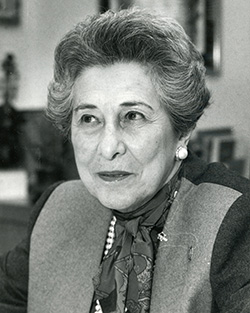 One of the things for which Popkin (right) is most remembered is serving as cochair of Hadassah’s first National Convention in Israel, in 1978. Dubbed the “Convention Without Walls,” it was attended by more than 3,000 delegates, who were transported on 65 buses to meetings and events all over the country.
One of the things for which Popkin (right) is most remembered is serving as cochair of Hadassah’s first National Convention in Israel, in 1978. Dubbed the “Convention Without Walls,” it was attended by more than 3,000 delegates, who were transported on 65 buses to meetings and events all over the country.
Popkin was active on the broader stages of the Zionist movement. In 1987, she was elected chair of the Presidium and president of the World Zionist Congress, the first woman to hold those positions. She served as a Hadassah delegate to seven Zionist Congresses, from 1966 to 2002. Immediately after her presidential term at Hadassah, she served as president of the Jewish National Fund.
Along with her husband, Morris Popkin, who died in 1979, Popkin was a major donor to Hadassah. The Hebrew University–Hadassah School of Medicine has a Ruth and Morris Popkin Chair in Health Administration. There is also a stone-paved mall on the campus of the Hadassah Medical Center named for Morris Popkin. In addition, the dining room at the Hadassah Neurim Youth Village is named for Ruth Popkin.
Meet the Veep: Kacy Spivack
From Brooklyn, New York, to El Paso, Texas, newlyweds Steve and Kacy Spivack searched for a welcoming community. Kacy Spivack’s quest led her to a young women’s Hadassah group, and a philosophy of volunteerism that continues to this day. Spivack (right) believes that to engage others, it takes a combination of friendship and, she says, “learning about the cause.”
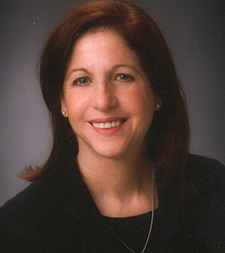 Personally, she credits Hadassah for giving her the courage to go to other parts of the world. The first time Spivack traveled on her own was with Hadassah. She marvels at the thrills that Hadassah has given her, citing the opportunity to put on a hard hat and visit the Sarah Wetsman Davidson Hospital Tower during construction. Hadassah makes her feel that she is part of something bigger than herself.
Personally, she credits Hadassah for giving her the courage to go to other parts of the world. The first time Spivack traveled on her own was with Hadassah. She marvels at the thrills that Hadassah has given her, citing the opportunity to put on a hard hat and visit the Sarah Wetsman Davidson Hospital Tower during construction. Hadassah makes her feel that she is part of something bigger than herself.
As a preschool teacher, Spivack was drawn to supporting Youth Aliyah; and she honored Steve, a dentist, with a contribution to the Hebrew University–Hadassah School of Dental Medicine. Today, the Hadassah Medical Organization is their priority. They feel strongly that the research in “our” hospitals helps people all over the world.
The Spivack family includes two married children, Pamela and Harris.
Kacy Spivack is chair of the Hadassah National Leadership Department and is a member of the Executive Committee. Back in Texas, she is board chairman of the El Paso Symphony. Kacy and Steve are generous members of the Circle of Founders. —Sandra King
Macular Degeneration
OpRegen is a first-of-its kind retinal pigment epithelial cell formulation derived from human embryonic stem cells—and it has now been approved for clinical trials by the United States Food and Drug Administration to treat the dry form of age-related macular degeneration.
The study will be conducted at Hadassah Medical Center, where 15 patients will receive a single dose (between 50,000 and 500,000 cells) of OpRegen into the subretinal space of the eye. The 15 patients will be tracked for a year following transplantation, with physicians evaluating the product’s safety and efficacy.
OpRegen was developed by Jerusalem’s Cell Cure Neurosciences, whose chief scientific officer is Dr. Benjamin Reubinoff, head of Hadassah Medical Center’s Human Embryonic Stem Cell Research Center. Cell Cure’s larger mission is to develop cell-based treatments for retinal and neurodegenerative diseases.
“This is a significant milestone for our company and in the broader development of therapies based on human embryonic stem cells for the treatment of major diseases,” says Dr. Reubinoff.
The Phase I/IIa study will provide preliminary data on the ability of the cell transplantation to slow the progression of dry-AMD, explains Dr. Eyal Banin, head of Hadassah’s Center for Retinal and Macular Degeneration, who collaborated with Dr. Reubinoff on OpRegen’s development.
Dry-AMD is the leading cause of old-age visual impairment and blindness in the developed world.
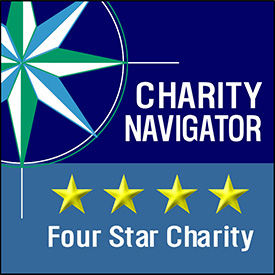
We’re No. 3!
At the close of 2014, Charity Navigator unveiled its list of “Ten of the Best Charities Everyone’s Heard Of.” Now, we’re thrilled to share that Hadassah came in at No. 3!
Earning a 98.75 score from the premier independent charity evaluator, Hadassah likewise maintains its four-star ranking this year. We are also the best “Jewish” charity everyone’s heard of: The only other Jewish organization to appear on the list is the American Jewish Joint Distribution Committee, coming in at No. 6.
On a Mission with Nurses and Physicians
Late last year, a group of physicians and nurses attended “From Concept to Cure: A Second Century of Healing,” a five-day continuing education conference in Jerusalem offered by the Hadassah National Physicians Council, Hadassah’s National Center for Nurses Councils, Hadassah Medical Organization and Emory University School of Medicine.
From November 2 to 6, in addition to joint sessions on groundbreaking topics in a variety of medical and surgical disciplines, nurses met with their Israeli counterparts for presentations by faculty and students from the clinical master’s nursing program at the Henrietta Szold Hadassah–Hebrew University School of Nursing. All conference sessions emphasized Hadassah’s “bench to bedside” approach to health care.
In keeping with the Every Beat Counts heart health initiative, the first day of group lectures featured research on reducing mortality from cardiovascular disease as well as early detection. Issues of gender and cultural disparity in cardiac symptoms were presented. Dr. Nanette Wenger of Emory University—honorary chair of the Hadassah Physicians Council—spoke specifically about gender differences in cardiovascular disease. Visiting doctors toured the four-story underground operating rooms under construction, designed to be explosion- and radiation-proof as well as safe from chemical and biological weapons. There was also the opportunity to see a nurse’s workroom, donated with funds raised by Hadassah Nurses Councils.
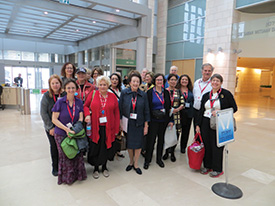
Both professions heard firsthand about stem cell research for patients with amyotrophic lateral sclerosis and multiple sclerosis, and viewed dramatic video of bedridden, disabled ALS patients able to walk after receiving treatments developed at Hadassah. Several ophthalmology lecturers presented developments in gene therapy and stem cell research to combat eye diseases.
Another highlight was hearing about the use of immunotherapy to target certain cancers—a subject lately in the news—with previously unheard-of results, particularly in patients with advanced melanoma.
Advanced-practice nursing faculty and students presented research on cultural competence, decision-making, palliative care, aging and sexuality—topics that arise while caring for Israel’s diverse populations. As an expression of the Nurses Councils’ partnership with the school of nursing, two American nurses also presented their research.
Medical professionals from Hadassah’s hospitals at Ein Kerem and Mount Scopus (both on the frontlines of terrorist attacks in Jerusalem) shared their recent experiences. At Mount Scopus, physicians met with several health care providers and patients—both Jewish and Arab Israeli. Nurses learned about the Open Class Project, a program developed by nursing students to bring together classmates of diverse ethnic and religious backgrounds. While touring the hospice center, an appreciative mother of a patient expressed gratitude for her daughter’s end-of-life care.
Pediatric HIV/AIDS specialist Dr. Dan Engelhard described to physicians the lifesaving work he and his team have done around the world: setting up field hospitals after disasters and working in orphanages in Ethiopia and Uganda. The group learned of Hadassah’s other global health initiatives, including hygiene, infectious disease control, CPR and first aid, circumcision and family planning.
As noted by Dr. Osnat Levtzion-Korach, director of Hadassah–University Hospital on Mount Scopus, Hadassah is truly “a bridge to peace in the Middle East,” staffed with health professionals making an impact in Israel and beyond.
Karen M. Ezrine, M.D. (cochair of the Hadassah National Physicians Council); Stacey J. Keen, M.D. (Hadassah National Physicians Council Steering Committee); and Dianne Gottlieb, M.S.N., C.N.M. (cochair of Hadassah’s National Center for Nurses Councils) contributed to this report.








 Facebook
Facebook Instagram
Instagram Twitter
Twitter
Leave a Reply